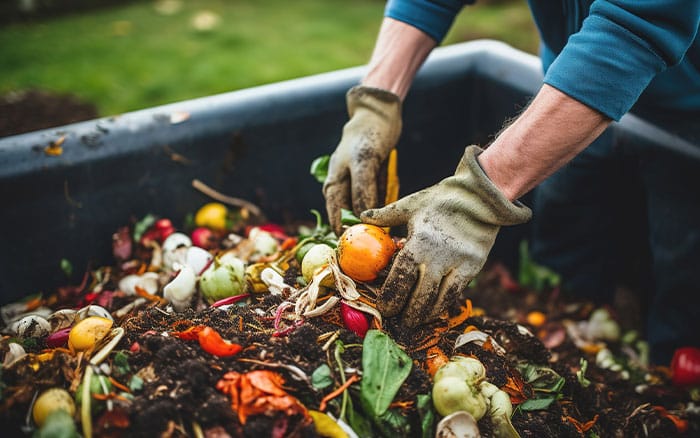Gardening gives a great platform for reducing waste. Find out some simple ways to reduce waste to benefit health and enhance efforts towards recycling, reusing and being green.
Food glorious food
One of the best parts about gardening is that it facilitates the full circle of life. Food crops grown in the ground can be harvested and their waste returned to the earth. This invigorates the soil, as it provides nutrients for new food crops. The additional bonus is that the amount of household waste going into a wheelie bin reduces in quantity too.
Consider investing in a compost heap. This will do wonders for your gardening experience. There’s so much satisfaction in creating your own soil. Furthermore, research by the University of Washington suggests that composting is better for the environment than waste left to rot in landfills. These release higher levels of methane, damaging the environment.

There’s also the fulfilment of knowing that, through composting, you end up with healthy soil.
Which will be really beneficial for crops. Research suggests that fertile soil produces healthier plants for sturdier nourishment.
Ecologists working with countries who have limited access to fresh food call this ‘biofortification’.
This is using agronomic practices, such as improving soil quality, to boost the nutrient density of food crops to avert malnutrition.
Compost Capabilities
Start capturing food waste by positioning a container near to the kitchen. Then, get into the habit of adding veg peelings that usually end up in general refuse. Eventually, it will fill up and you can transition to your composter.
I use a clean bucket with a bin liner. When it’s full, I use the bucket handle to carry it to the compost bin. With a large variety of composting methods available, you’re sure to find one to suit. There are small bins, tumblers, or hot composters that add heat to speed to process—even wormeries are effective.
Just remember to position new composters away from the house and keep them covered. This will help reduce odours, pests, and the risk of inhaling the fungi and bacteria involved in the decaying process. This is particularly significant in intimate garden spaces. It’s also worth keeping in mind that the bigger the composter, the faster it breaks down material. Wherever possible, go for a larger heap to keep the heat.
The key to quality compost is to get the recipe right; equilibrium is everything. You need both ‘green’ and ‘brown’ material present to encourage both nitrogen and carbon production. Both are required for fertile soil. Aim for 25-50% of quick-rotting green material, like clippings or veg peelings, and 50-75% slow-rotting brown material, like woody growth or cardboard. Then, you will strike the right balance.
Use your eyes to guide your additions from there. If it’s looking dry, incorporate some moisture-rich green waste and, if wet, brown material will soak up excess moisture. Aeration is vital for healthy compost. Keep the air flowing through regular turning to help the microorganisms thrive. These will break down the decaying matter into a finer soil structure, which improves drainage too.

Waver water waste
If composting has given you a taste for reducing waste, consider the other natural resources that you can utilise. Rainwater can be collected to benefit your plants because it isn’t chemically treated with chlorine like household water supplies. Rainwater is also brilliant for keeping the pH of your soil balanced. Tap water may contain lime which reduces the acidity of soil—particularly an issue for ericaceous plants, like blueberries.

You can make the most of this free supply by installing a water butt. One water butt will fill a watering can about 25 times, enough water for a medium-sized container throughout the summer.
Perhaps trial the volume of water you require by installing one butt first. Water optimisation will then go one step further by making the most of the water you apply.
For example, having healthy soil and working in mulch are quick ways to lock in moisture and reduce evaporation.
There’s no better way to limit waste than to make the most of what you’ve already got.
Greener gardens
Creating your own crumbly compost is an effective way to lessen synthetic approaches to crop cultivation. As compost is soil that is naturally rich and fertile, it puts up a better defence against diseases and weeds. Of course, catching and storing rainwater is valuable to the environment too.
Channel the water that falls onto the roof of your shed or greenhouse during the wet season.
This can then be stored. Such efforts will have a knock-on effect in the dry season when rainfall is scarce.
Water reserves don’t have to be drained by water companies to deliver the higher demands. And this, in turn, has benefits to energy saving.

All gardening efforts have a ripple effect on the wider ecosystem and, if you’re growing crops, your health too. Take the opportunity to try some of these methods towards tightening the reins on waste. You’ll find your garden becomes more sustainable, bountiful and bursting with benefits.

Leave A Comment